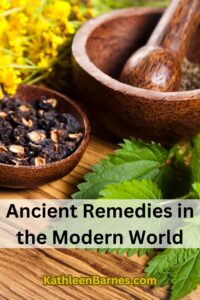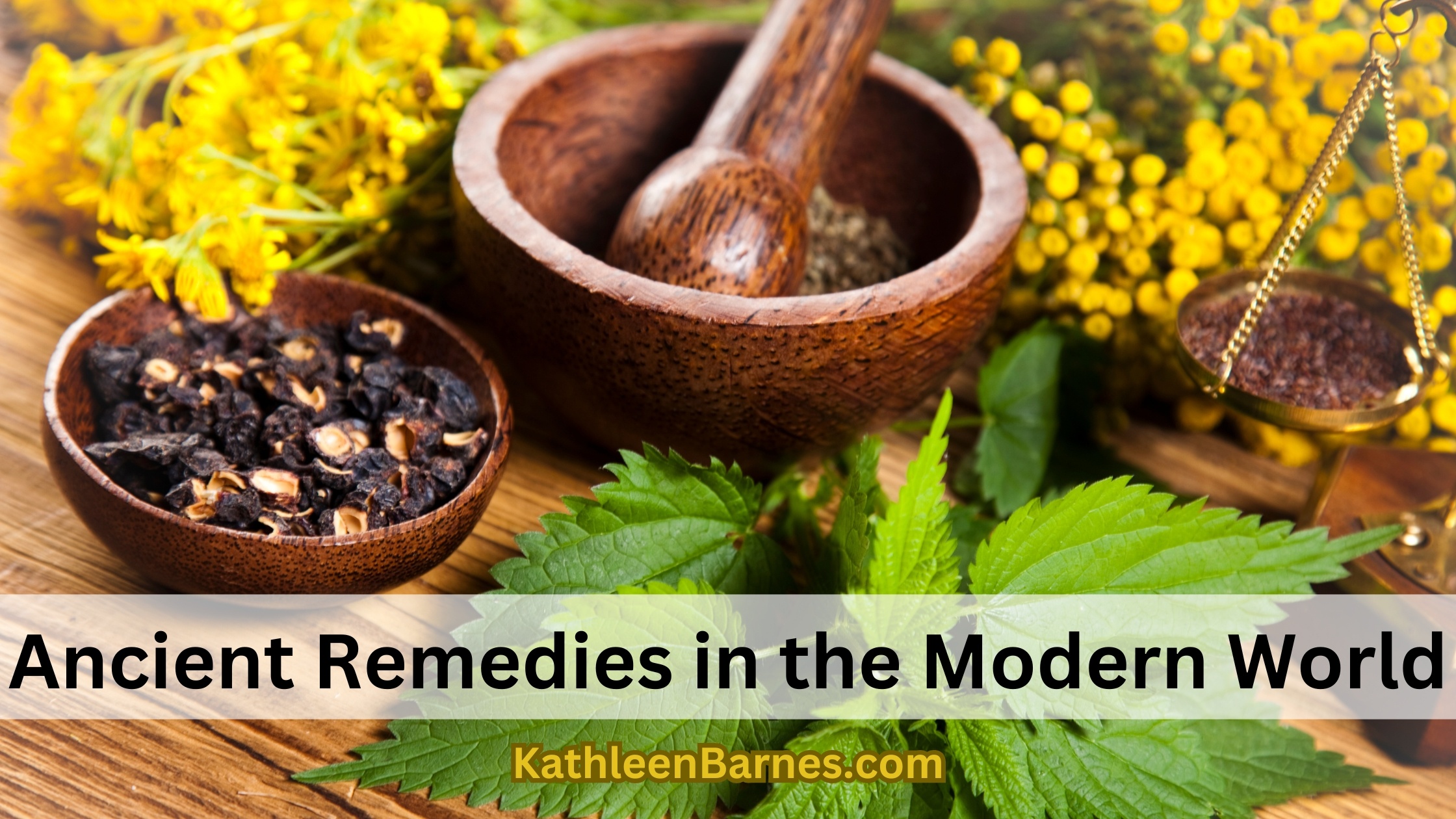In recent years, society has generally become more health-conscious. There is more information circulating about our food, what’s in it, and how that can affect our overall health. Old adages like “you are what you eat” really are accurate.
There is a fine line between natural remedies sometimes between natural remedies and snake-oil quackery, but the underlying wisdom in ancient remedies promoting health and well-being cannot be ignored.
underlying wisdom in ancient remedies promoting health and well-being cannot be ignored.
Oftentimes, natural remedies are cheaper, and more effective than modern medicines with their side effects. However, this isn’t an idea you can apply across the board. Natural isn’t always better.
Understanding and integrating ancient remedies into modern healthcare is the key. Discussing this with your healthcare professional is a must. A knowledgeable doctor will be able to advise you on natural and modern approaches and practices to enrich your care routine and enhance your overall well-being. Don’t neglect this step.
Historical Context of Ancient Remedies
Overview of Various Traditional Healing Systems
Ayurveda: Originating in India over 3,000 years ago, Ayurveda is one of the world’s oldest holistic healing systems. It focuses on balancing the body’s energies, known as doshas, to maintain health and prevent disease. Ayurveda emphasizes the use of herbal medicines, dietary practices, and physical therapies like yoga and meditation.
Traditional Chinese Medicine (TCM): With a history spanning over 2,500 years, TCM is based on the concept of Qi (vital energy) flowing through the body’s meridians. Techniques such as acupuncture, herbal medicine, and tai chi aim to balance Yin and Yang, the dual forces believed to govern health.
Indigenous Practices: Indigenous healing traditions vary globally but share common themes of community-based care, spiritual rituals, and the use of natural resources. Native American, Aboriginal Australian, and African traditional medicines often involve plant-based treatments, spiritual ceremonies, and holistic health practices.
Key Historical Figures and Their Contributions
Charaka and Sushruta: In Ayurveda, Charaka is known for his contributions to internal medicine, as documented in the Charaka Samhita, while Sushruta is celebrated for his pioneering work in surgery, detailed in the Sushruta Samhita.
Huangdi (The Yellow Emperor): Often regarded as the father of TCM, Huangdi’s “Yellow Emperor’s Inner Canon” (Huangdi Neijing) is a foundational text that outlines theories of disease, diagnosis, and treatment.
Hippocrates: Known as the “Father of Medicine,” Hippocrates significantly influenced ancient Greek medicine. His holistic approach to health and the famous Hippocratic Oath underscore the importance of ethics in medical practice.
Avicenna (Ibn Sina): A Persian polymath whose works, particularly “The Canon of Medicine,” integrated various medical traditions, including Greek, Roman, and Persian, and became a reference in both the Islamic world and Europe for centuries.
Common Ingredients and Methods Used in Ancient Remedies
Herbal Medicine: A cornerstone of many traditional healing systems, herbs like turmeric, ginger, ginseng, and garlic have been used for their medicinal properties. These herbs often serve as anti-inflammatories, antimicrobials, and antioxidants.
Acupuncture and Moxibustion: Central to TCM, acupuncture involves inserting fine needles into specific points on the body to balance Qi, while moxibustion involves burning moxa (dried mugwort) near the skin to stimulate circulation and enhance healing.
Diet and Nutrition: Traditional diets emphasize the therapeutic properties of food. Ayurveda, for example, prescribes dietary practices based on one’s dosha, while TCM focuses on balancing the body’s energies through hot and cold foods.
Mind-Body Practices: Techniques such as yoga in Ayurveda and tai chi in TCM promote physical health, mental clarity, and spiritual growth. These practices help reduce stress, enhance flexibility, and improve overall well-being.
Spiritual and Ritualistic Practices: Indigenous healing often involves ceremonies and rituals to restore harmony and balance. These practices may include drumming, chanting, and the use of sacred plants like tobacco and sage for their spiritual and medicinal benefits.
By understanding the historical context and foundational elements of these ancient remedies, we can appreciate their relevance and application in today’s healthcare landscape. These traditional practices offer a holistic approach that not only addresses physical ailments but also promotes mental and spiritual well-being.
Benefits of Ancient Healing Practices
Holistic Approach to Health and Wellness
One of the most significant benefits of ancient healing practices is their holistic approach to health and wellness.
Unlike modern medicine, which often focuses on treating specific symptoms or conditions, traditional healing systems consider the whole person.
This means addressing physical, mental, emotional, and spiritual health to achieve overall well-being.
By adopting a holistic approach, ancient healing practices encourage lifestyle changes and preventive measures, fostering long-term health rather than just short-term relief.
This comprehensive perspective helps individuals achieve a balanced state of health, enhancing their quality of life and resilience against illness.
Natural and Sustainable Ingredients
Ancient healing practices rely heavily on natural ingredients, which are often more sustainable and environmentally friendly compared to synthetic pharmaceuticals.
Herbal medicine, a cornerstone of many traditional systems, uses plants and natural substances to treat various ailments and support overall health.
Using natural ingredients not only reduces the risk of side effects associated with synthetic drugs but also supports sustainable practices.
Many traditional healing systems emphasize the importance of respecting and preserving nature, promoting ecological balance and biodiversity.
Long-Standing Efficacy and Safety Records
Ancient healing practices have stood the test of time, with many having been used effectively for thousands of years. The longevity of these practices is a testament to their efficacy and safety.
Historical texts and traditional knowledge passed down through generations provide a rich source of information on the benefits and applications of various remedies.
Moreover, the extensive use of these remedies over centuries has allowed for a thorough understanding of their safety profiles.
Traditional healers and practitioners have developed detailed knowledge about the appropriate use, dosages, and potential side effects of various treatments.
This long-standing track record provides a level of assurance that is often lacking with newer, less-tested pharmaceuticals.
The benefits of ancient healing practices are manifold. Their holistic approach to health and wellness ensures a balanced and comprehensive treatment.
Popular Ancient Remedies Making a Comeback
Herbal Medicine
Turmeric: Known for its vibrant yellow color and distinctive flavor, turmeric has been used for thousands of years in Ayurvedic and traditional Chinese medicine. The active compound in turmeric, curcumin, has potent anti-inflammatory and antioxidant properties.
Modern research supports its use in managing conditions such as arthritis, digestive issues, and even cancer. Many people now incorporate turmeric into their diets through golden milk, teas, and supplements to harness its health benefits.
Ginger: Ginger has been a staple in various traditional medicine systems for its digestive and anti-inflammatory properties. It is commonly used to alleviate nausea, reduce muscle pain, and manage inflammation.
Scientific studies have confirmed ginger’s effectiveness in treating nausea caused by pregnancy, chemotherapy, and motion sickness.
Today, ginger is widely available in various forms, including fresh root, dried powder, and as an ingredient in teas and supplements.
Ginseng: Revered in traditional Chinese medicine, ginseng is believed to boost energy, improve cognitive function, and enhance immunity.
There are several types of ginseng, including Asian ginseng (Panax ginseng) and American ginseng (Panax quinquefolius), each with unique properties.
Research has shown that ginseng can improve mental performance, reduce fatigue, and support immune health. As a result, ginseng supplements and teas have gained popularity as natural energy boosters and adaptogens.
Acupuncture and Acupressure
Acupuncture: This ancient practice involves inserting thin needles into specific points on the body to balance the flow of Qi (vital energy).
Acupuncture is widely used to manage pain, reduce stress, and treat various health conditions, including migraines, anxiety, and insomnia.
The World Health Organization (WHO) recognizes acupuncture as an effective treatment for over 30 conditions. Its growing acceptance in Western medicine has led to its inclusion in many integrative healthcare settings.
Acupressure: Similar to acupuncture but without needles, acupressure involves applying pressure to specific points on the body to relieve pain and promote healing.
It is often used for pain relief, stress reduction, and improving circulation. Studies have shown that acupressure can be effective in alleviating headaches, menstrual cramps, and nausea.
This non-invasive technique is easy to learn and can be practiced at home, making it an accessible option for many people seeking natural remedies.
Mind-Body Practices
Yoga: Originating in ancient India, yoga is a holistic practice that combines physical postures, breathing exercises, and meditation to promote physical and mental well-being.
Yoga has been shown to improve flexibility, strength, and balance while reducing stress and anxiety. It is widely practiced worldwide in various styles.
Meditation: Meditation is an integral part of many traditional healing systems, including Buddhism and Hinduism.
It involves techniques such as mindfulness, focused attention, and loving-kindness to cultivate mental clarity, emotional stability, and inner peace.
Scientific research has demonstrated that regular meditation can reduce stress, improve concentration, and enhance emotional well-being.
Practical Tips for Incorporating Ancient Remedies into Daily Life
How to Choose and Use Herbal Supplements Safely
Consult a Healthcare Professional: Before adding any herbal supplements to your routine, it’s essential to consult with a healthcare professional, especially if you have existing health conditions or are taking other medications. This ensures that the supplements are safe and appropriate for your individual needs.
Research and Select High-Quality Products: Not all herbal supplements are created equal. Look for products that are standardized and have been tested for purity and potency. Reputable brands will often have certifications from third-party organizations like the USP (United States Pharmacopeia) or NSF International.
Start with Recommended Dosages: Follow the dosage instructions provided on the supplement label or by your healthcare provider. Starting with the recommended dosage helps prevent potential side effects and allows you to assess how your body responds to the supplement.
Be Aware of Potential Interactions: Some herbs can interact with medications or other supplements. For example, St. John’s Wort can interfere with antidepressants, and garlic supplements may affect blood thinning medications. Always check for potential interactions.
Monitor Your Response: Pay attention to how your body reacts to the supplement. If you experience any adverse effects, discontinue use and consult your healthcare provider.
Simple Mind-Body Practices to Reduce Stress and Improve Well-Being
Yoga: Incorporate a short yoga routine into your daily schedule. Even 15-20 minutes of yoga can help improve flexibility, reduce stress, and enhance overall well-being. You can follow online tutorials or join a local class to get started.
Meditation: Practice mindfulness meditation for a few minutes each day. Find a quiet space, sit comfortably, and focus on your breath. Apps like Headspace or Calm can provide guided meditations to help you develop a regular practice.
Deep Breathing Exercises: Engage in deep breathing exercises to calm your mind and body. Try the 4-7-8 technique: inhale for 4 seconds, hold your breath for 7 seconds, and exhale slowly for 8 seconds. Repeat this cycle a few times to reduce stress and promote relaxation.
Tai Chi or Qigong: These gentle martial arts practices focus on slow, deliberate movements and deep breathing. They can improve balance, flexibility, and mental clarity. Look for beginner classes at community centers or online platforms.
Recipes and DIY Remedies to Try at Home
Golden Milk (Turmeric Latte)
Kathleen has written at length about the active compound in turmeric called curcumin. Read more here.
– Ingredients: 1 cup milk (dairy or plant-based), 1 teaspoon turmeric powder, 1/2 teaspoon cinnamon, a pinch of black pepper, 1 teaspoon honey or maple syrup (optional).
– Instructions: Heat the milk in a saucepan over medium heat. Add the turmeric, cinnamon, and black pepper. Stir well and simmer for a few minutes. Add honey or maple syrup if desired. Pour into a cup and enjoy a warm, soothing beverage.
Ginger Tea
– Ingredients: 1-2 inches of fresh ginger root, sliced, 2 cups water, 1 tablespoon honey (optional), 1 tablespoon lemon juice (optional).
– Instructions: Boil the water in a pot, then add the sliced ginger. Reduce heat and simmer for 10-15 minutes. Strain the tea into a cup and add honey and lemon juice if desired. This tea is excellent for digestion and reducing inflammation.
Herbal Bath Soak
– Ingredients: 1 cup Epsom salt, 1/2 cup baking soda, 1/4 cup dried lavender flowers, 1/4 cup dried chamomile flowers, a few drops of essential oils (lavender or chamomile).
– Instructions: Mix all the ingredients in a bowl. Draw a warm bath and add the mixture. Soak for 20-30 minutes to relieve stress and soothe muscles.
Homemade Elderberry Syrup
Kathleen makes this syrup, and here’s her article on that.
– Ingredients: 1 cup dried elderberries, 4 cups water, 1 cup honey, 1 teaspoon cinnamon, 1/2 teaspoon cloves, 1 teaspoon grated ginger.
– Instructions: Combine the elderberries, water, cinnamon, cloves, and ginger in a pot. Bring to a boil, then reduce heat and simmer for 45 minutes. Strain the mixture and discard the berries. Allow the liquid to cool slightly before stirring in the honey. Store in a glass jar in the refrigerator. Take a tablespoon daily to boost your immune system.
Challenges and Considerations
Potential Risks and Side Effects of Traditional Remedies
While ancient remedies offer many benefits, it is essential to be aware of their potential risks and side effects. Herbal supplements and traditional treatments can interact with medications, cause allergic reactions, or lead to other adverse effects if not used correctly.
Importance of Consulting Healthcare Professionals
Consulting healthcare professionals before incorporating traditional remedies into your health regimen is essential. This ensures that the remedies are appropriate for your specific health needs and do not interfere with any existing treatments.
Final Thoughts
Rediscovering ancient remedies offers a wealth of benefits, from promoting holistic health and well-being to utilizing natural and sustainable ingredients.
These time-honored practices have been validated through centuries of use and are increasingly supported by modern research.
By integrating traditional healing practices with contemporary medicine, we can achieve a more balanced and comprehensive approach to health.
Embrace the wisdom of the past and enrich your modern life with the benefits of ancient remedies. Here’s to a healthier, more balanced, and vibrant you!







